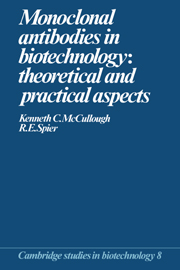Book contents
- Frontmatter
- Contents
- Acknowledgements
- 1 Introduction: the immune response
- 2 Making hybridomas (hybridoma technology)
- 3 Factors affecting successful hybridoma production
- 4 Selection of monoclonal antibody-secreting hybridoma cell lines
- 5 The large-scale production of monoclonal antibodies in vitro
- 6 In conclusion: the diversity in application of monoclonal antibodies and hybridoma technology
- References
- Index
3 - Factors affecting successful hybridoma production
Published online by Cambridge University Press: 23 November 2009
- Frontmatter
- Contents
- Acknowledgements
- 1 Introduction: the immune response
- 2 Making hybridomas (hybridoma technology)
- 3 Factors affecting successful hybridoma production
- 4 Selection of monoclonal antibody-secreting hybridoma cell lines
- 5 The large-scale production of monoclonal antibodies in vitro
- 6 In conclusion: the diversity in application of monoclonal antibodies and hybridoma technology
- References
- Index
Summary
In Chapter 2, the theory of hybridoma generation was described, and the variation in methodology used was discussed. The procedures for the production of hybridomas may differ substantially for different antigens; §2.5.2 showed how the immunisation schedule used for one antigen may not be optimal for another. The use of different myeloma cell lines can also produce different results (see §2.5.8). Thus, the determination of the optimal conditions for generating hybridomas against a particular antigen is central to the success of the technology. Chapter 3 will expand on the discussion of Chapter 2 concerning factors which are influential in the successful generation of hybridomas.
The use of different immunisation protocols for different antigens and how these influence the type of immune response generated was introduced in Chapter 2 (§2.5.2). In this chapter, §3.1 will look at the relative efficacy of different immunisation schedules, and the reasoning behind choosing a particular protocol for a particular antigen. Chapter 2 identified the major influential factors in the fusion event as the myeloma cell, the fusing agent (usually PEG) and the fusion ratio. How the source of myeloma cell, source of PEG and fusion ratio can influence the success of hybridoma production will be discussed in this chapter (§§3.2–3.4), since the physical generation of hybridomas is probably the most important, sensitive and delicate of the in vitro steps.For fusion to occur, cell membrane structure must be drastically altered, and thus slight variations in the toxicity of the fusing agent can be detrimental to the success of generating hybridomas. Likewise, the fusion ratio (splenocytes : myeloma cells) must be such as to guarantee fusion between myeloma cells and some antigen-specific lymphocytes.
- Type
- Chapter
- Information
- Monoclonal Antibodies in BiotechnologyTheoretical and Practical Aspects, pp. 138 - 184Publisher: Cambridge University PressPrint publication year: 1990

